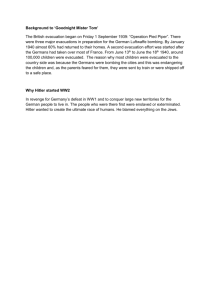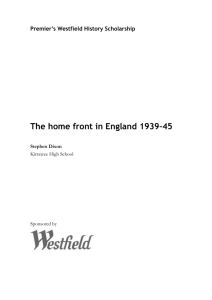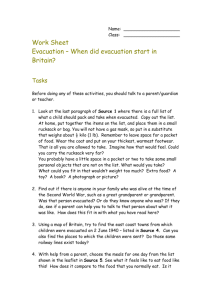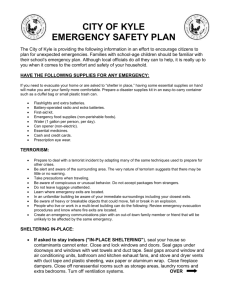File - SHAPING THE MODERN WORLD
advertisement
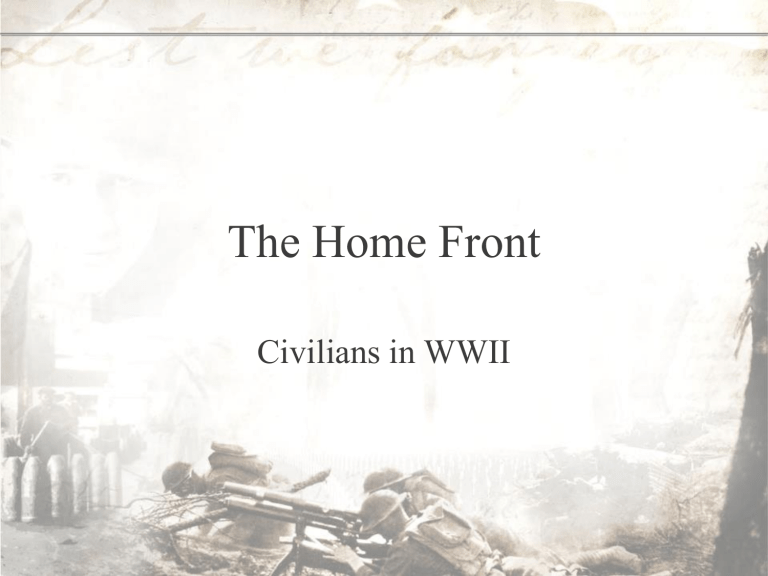
The Home Front Civilians in WWII The Blackout • Started in 1939 to prevent enemies from being able to see where to drop bombs • All lights were to be switched off or turned down. Street lamps and neon lights were turned off. Special hoods were placed over the headlights of cars allowing only a tiny slit of light to light the road ahead The Blackout • Pillar-boxes were painted yellow, white stripes were painted on the roads and on lamp-posts. • Blackout curtains were made to stop light escaping from windows in ordinary houses. • Men were advised to leave shirttails hanging out so cars would be able to see them better. • Began half an hour after sunset and ended half an hour before sunrise. The Blackout • After the first night, posters were issued to warn people to "Watch out in the Blackout" as many people were injured tripping up, falling down steps, or bumping into things. • September 1939- the first month- the number of people killed in road accidents increased by 100%. Londoners were not only finding it hard to see, they were finding it hard to be seen Gas Masks • By September 1939 nearly everybody in the England had been issued with a gas mask (38 million). • People instructed to carry their gas masks at all times in case of attack. • Adults had masks that looked like a pig-snout and the children's were soon given nicknames such as Mickey Mouse and Donald Duck. Even babies had gas masks that they could be placed inside. Gas Masks • There was fear that the Germans would use gas, possibly launched from planes or boats • Gas had been used on the battlefields during the First World War but had not been used on civilians. • Lots of work places had tests where staff had to wear a mask while working for 15 minutes and schools held frequent practices Gas Masks • There were no gas attacks on the mainland of Britain in the Second World War and so the gas masks were never used. • Therefore the effectiveness of the preparations was never tested. Other Safety Measures • Sandbags stacked in the doorways of important buildings, used inside basement shelters to protect from falling bricks of damaged walls. • Paint and tape painted the tops of red mailboxes with yellow gasdetection paint that changed color to warn people of poisonous gas in the air; Londoners were encouraged to take own measures such as gas-proofing a room in their house with cellulose sheets taped onto walls. Strips of masking tape were put on windows to stop them from shattering in a bomb blast. Soon all the materials needed to take such measures were difficult to obtain or expensive to buy. Other Safety Measures • Barrage balloons Silver balloons put in the skies over London. Also called 'blimps‘. An anti-aircraft device. Prevented planes from making dive-bomb attacks or low-flying raids. Other Safety Measures • Anti-aircraft guns Guns were set up on reinforced sites in London to shoot down enemy planes or stop them from attacking the city. About 1/3 of all the German planes destroyed over London were shot down by anti-aircraft guns. • Searchlights To help the guns and the fighter pilots spot enemy planes, powerful searchlights, twenty million times more powerful than an ordinary light bulb, would probed the night sky Interns • Anyone in Britain who was German, Austrian or Italian was interned • Meant that they were put in prison • The government was very worried that foreigners from a country Britain was at war with might tell the enemy about troop movements or send them important industrial information. Interns • Many were refugees who came to Britain because Hitler had threatened to kill them or put them in concentration camps. • Over 8,000 people were interned and, of these, about 5,000, including women and young children. • Were sent to Port Erin and Port St Mary on the Isle of Man. • They were held in crowded housing and separated from the rest of the island by barbed wire fencing. Interns • As the war progressed, the government released many of the internees who were judged not to be a threat back to their homes but some spent the whole war there • In America, Japanese were arrested in a similar way after Pearl Harbor Spies • As soon as the war broke out, many people became very concerned that the country would be full of German spies. • This belief was strengthened when the government decided to intern large numbers of Germans and Austrians. • It appeared that secret agents could be anywhere. Spies • The government was also worried by the possible presence of a Fifth Column-people working or spying for the enemy- in the country. • The department responsible for propaganda, the Ministry of Information, began a campaign called 'Careless Talk Costs Lives'. Spies • Many of the posters were designed to be funny. • The other famous slogan used on posters was 'Keep Mum - she's not so dumb‘ • This also encouraged people not to gossip or talk about the war effort in case their conversations were overheard by spies. • Very successful- It worked because people found the message easy to understand and liked the fact that the posters were funny. The Home Guard • British and French armies were defeated in France by the Germans May 1940 • The future looked very bad. • Britain was the last big country in Europe still fighting Hitler and faced the real threat of an invasion from the Germans across the sea from France. The Home Guard • British army was badly weakened by the defeat in France so the government quickly set up a volunteer army • Originally called the Local Defence Volunteers, later known as the Home Guard. • It was sometimes nicknamed 'Dad's army' because it was made up of volunteers who were too old to serve in the regular army. The Home Guard • Hundreds of thousands of men joined the Home Guard in the summer of 1940 and served through the war. • Did not have proper weapons or uniforms • Began training to resist an enemy invasion and soon began performing a number of roles • It was expected, but the Germans did not try to invade • The Home Guard never faced an invading force so it is unsure how they would have fought. The Blitz • In June 1940, after the defeat of France, Germany prepared to invade Britain • German leaders felt it was essential to destroy the British air force to stop it sinking the ships that would carry German soldiers across the Channel. • Bombing raids on Britain started in July The Blitz • August- German air force concentrated its attack upon airfields, aircraft factories and radar stations. • The Royal Air Force fought back in the Battle of Britain. • The German air force nearly succeeded in crippling the British air force, but its losses of aircraft and aircrew were very high, and the invasion was postponed. The Blitz • To force Britain to surrender, attack was switched to other targets: such docks, factories and railways. • Bombing was not accurate, and most of these targets were in cities and towns • Many bombs fell upon streets and houses, killing people and destroying property. • From October 5, the German raids took place only at night and the British defenses of antiaircraft guns and night fighters could not stop them. The Blitz • British planes went on bombing raids to Germany, attacking factories, cities and towns - especially the capital, Berlin. • Many places in Britain were badly damaged during the Blitz, but this did not stop war production or force Britain to surrender. • Over 30,000 British people were killed during this period - over half in London, which was bombed almost every night. The Blitz • The Blitz ended in mid-May 1941, when much of the German air force was sent east to prepare for the invasion of Russia. • The immediate threat of a German invasion of Britain was over • Bombing was to continue at less intensive levels in 1942 and 1943. Air Raid Wardens • Each London borough was divided into districts, Each district was split into different posts. Each post would be split into six or more sectors that had between three and six wardens serving under a senior warden. Air Raid Wardens • Warden patrolled an area covering several streets. • Divided into manageable areas for the purposes of bomb surveillance. • Each warden had to report to his or her post where and when a bomb had exploded. • After reporting the warden would return to the scene to look after those shocked and wounded before the emergency services of the Civil Defence would arrive. Air Raid Wardens • During this time the warden would have to put out any small fire and direct those who were made homeless to the nearest rest center • A good warden could attend to minor fires and injuries without needing to alert Civil Defence. • One in six wardens were women. • The official hours for an ARP worker were 72 per week but in reality they were much more. Auxiliary Fire Service • The AFS was created to support the regular London Fire Brigade. • This new service needed equipment so many of London's black taxicabs were taken over by the Civil Defence, painted grey and turned into makeshift fire engines. • The first night of the Blitz, 9 AFS brigades used 100 fire engines each to extinguish the widespread fires. Auxiliary Fire Service From the memoirs of a fire-fighter at the height of the Blitz, working in the docklands: "There were pepper fires, loading the surrounding air heavily with stinging particles so that when a fireman took a deep breath it felt like breathing fire itself. There were rum fires, with torrents of blazing liquid pouring from the warehouse door and barrels exploding like bombs themselves. There was a paint fire, another cascade of white hot flame, coating the pump with varnish that could not be cleaned off for weeks. A rubber fire gave forth black clouds of smoke that could only be fought from a distance, always threatening to choke the attackers". [Sir Aylmer Firebrace, 'Fire service Memoirs' (Melrose, 1949) pp.168-9; MOI, 'Front Line' (HMSO, 1942), pp.25-6] Homelessness • Many survivors of the Blitz were faced with homelessness • Between September 1940 and May 1941, 1,400,000 Londoners were made homeless • 1 in every 6 Londoners found themselves without a place to live. Homelessness • Those who lived in the poor areas such as the East End suffered particularly badly. • Houses in these areas were in a bad state of repair to begin with and were destroyed easily by the bombs. • By 11th November 1940, 4 out of 10 houses in Stepney had been damaged. Shelters • Bombing of Britain did not start immediately. • People developed a false sense of security and were not keen to have shelters. • Once heavy bombing began, from the summer of 1940 onwards, shelters became more popular. Shelters • In London, people slept at night in the Underground Stations and tunnels. • The shelters saved the lives of many people, but there were deaths when large bombs fell directly on shelters. • Many people could be killed at once - for example, 64 died at Balham Underground Station when it took a direct hit on 15 October 1940. Shelters • When war began, London had its own readymade shelter system - the Underground. • Many Londoners used the Tube as their fulltime or part-time shelter from the air raids. • At first this was disorganized with people sleeping when and where they could, even when the trains started running again in the morning . • At the peak of the Blitz, near the end of September 1940, 79 Underground stations were being used as shelters and 177,000 were sleeping in them Shelters • After being approved, sheltering had to be organized by local government and Civil Defence. • 79 stations were fitted with bunks, first aid clinics, and chemical toilets. • On November 25th 1940, the first of 22,000 specially made triple-bunk beds were fitted into the deep Tube stations at Lambeth North. • From 29th October 1940 there were even 124 canteens throughout the system, with food delivered by special trains. Shelters • Health and sanitation problems were addressed by issuing posters with the message "Coughs and Sneezes Spread Diseases" and giving general advice on how to stay healthy. • Many Londoners found shelter wherever they could - in churches, in wine cellars, in boiler rooms. Shelters • In March 1940, the government asked local authorities to build brick and concrete shelters on the surface. • These were usually at the end of streets or under railway arches and were used by the people living in that street, perhaps about 50 people in total. • A shortage of concrete meant that many of these shelters were not that strong. • They were cold, damp, and dark, ventilation was poor. Shelters • Trench shelters were also built in public parks and gardens, dug into the ground, lined, and then given roofs of either concrete or steel. • They normally contained about 50 people but were unpopular because they used to flood very easily. • No matter what the accommodation, when families were bombed out of their home they found a corner of some shelter and tried to make do as best they could. Shelters • The Tube was also used by government and industry. Special offices were built in disused passages and on the platforms • Sometimes the War Cabinet met in the Tube shelters to escape the bombing. Anti Aircraft Control used another disused station as its headquarters. • Some factories were also placed underground Shelters • By the end of the War, German bombing had killed just over 60,000 people in Britain. However, many more would have died if shelters had not been provided. Home Shelters • In November 1940 the Most Londoners stayed in their homes, sleeping downstairs, under stairs, under tables, in cupboards. • If they used a shelter at home then it would have been either an Anderson or a Morrison shelter. Anderson Shelter • 2,250,000 Anderson shelters were given away free at the start of the Blitz. • The roof was made of corrugated steel and was dome-shaped, the roof was bolted to strong rails and the structure was put 3ft underground with 18 inches of earth on top. • People constructed Anderson shelters in their back gardens. • tended to flood regularly, the space inside was generally too small for a family to sleep in, it didn't keep the noise of the air raids out, and war-time shortages of steel meant that after a time they had to be stopped being produced. Anderson Shelter Morrison Shelter • It was a family shelter, free for most people • Could be kept indoors- helped to reduce noise, it got rid of the flooding problem, and it helped to minimize disruptions made to normal home life • It had a steel roof, wire mesh sides, and could be used as a table during the day. • It was 2ft 9 inches high and was just big enough to sleep in. • 5000,000 were given out by November 1941 Morrison Shelter Evacuation of Children • By 1934, officials made secret plans to move infants, schoolchildren and some adults to the countryside if war began. • In 1938, during the Munich crisis, evacuation was very nearly started in Britain, but war was avoided and children remained at home. Evacuation of Children • More detailed evacuation plans were prepared after the crisis. • Evacuation was to be voluntary, with parents deciding whether to send their children away. • September 1939, evacuation commenced several days before Britain entered the war. • Schoolchildren, their teachers, mothers with children under five, pregnant women, and some disabled people were moved by train and road to smaller towns and villages in the countryside. Evacuation of Children • The evacuation plan worked very well and 1½ million children and adults were moved within 3 days, including 600,000 from London. • The government was disappointed because it had hoped to evacuate 3 million people. More than half of all schoolchildren did not leave their homes in the cities and towns. • There were no big bombing raids on Britain in the first months of the war and, by early 1940, many children had returned home. Evacuation of Children • In June 1940, following the defeat of France, there was a large evacuation of children from the east and southeast coasts to safer areas. • When the blitz started there was another big evacuation • Later, in 1944, a further large evacuation of children and mothers took place. This was the last evacuation of the war. Most evacuees were able to return home during 1945. Some, though, were orphans, because their parents had been killed in air raids. Evacuations of Children • Most London children were evacuated through their schools. • Altogether 827,000 school children were evacuated along with 103,000 teachers and helpers. • 524,000 children under the school age went with their mothers. • 12,000 pregnant women also left the city to protect their unborn children. Evacuation of Children • Some children went to foster homes on farms, some to cottages, some to the manor house (where the care of several children might be left to the servants). • Many Londoners who were moved to the countryside found that they and their country hosts came from completely different worlds. • Londoners thought that country folk would be backward, old-fashioned and snobbish. • The country hosts thought their guests from London would be dirty, loud, ill mannered and lice-ridden. Evacuation of Children • Evacuation forced people to face issues concerning the differences and imbalances of social class • Evacuation introduced one half of Britain to the other half, inner city to country, middleclass to working-class. Evacuation of Children • Some children missed their families, friends and familiar city streets. Sometimes their new foster parents did not understand them or treated them harshly. • For others, it was the best time of their lives and they enjoyed the fresh country air, good country food and lots of new things to do. • One schoolteacher wrote: • "All of the evacuees have gained an experience and a broadened outlook which will inevitably modify their future lives. A deeper understanding will, I hope, arise between the peoples of our own land" Farming • In 1939 farming became part of the war effort, a state controlled industry whose aim was to feed wartime Britain. • Food imports had to be reduced because the ships were needed to transport guns, planes and soldiers, and the best way to reduce imports was to grow more food. Farming • "Dig for Victory" was the slogan of a campaign started by the government to encourage people to grow more food. • Made sure that every available piece of land was turned over to agriculture. • Nearly half the families in London had a garden to grow their own vegetables Farming • Growing your own food or rearing your own animals was a good way to add to your rationed food. • Even evacuated children were expected to do their bit and care for their own gardens • In 1939, the number of acres of land used for food production was just under 12 million, in 1945 this had grown to just over 18 million acres. • Between 1939 and 1945, imports of food were halved. Rationing • Rationing of food was introduced in January 1940. • Everybody was issued with a ration book that contained coupons that had to be handed in to the shops every time rationed food was bought. • As well as the basic ration everybody had 16 coupons each month that they could spend on what they wished. Rationing • This made sure that everyone was able to buy and eat the basic food necessary to keep them fit and healthy. • Bacon, butter and sugar were among the first things to be rationed. • Some foods such as potatoes, fruit and fish were not rationed. • People were able to buy these things, provided they could afford them and there were supplies in the shops. Rationing • Although there was less food, Britons seemed to be better fed. • They ate less fat, less meat and more vegetables. • Their average calorie intake fell from 3,000 to 2,800 per day. • With special food, drink and vitamin supplements for babies and pregnant mothers, infant mortality fell from 51to 46 per thousand live births during the war. Rationing 1940 1941 1942 Jan Bacon Jan Sugar March Meat July Tea July Butter and Margarine March Jam May Cheese June Eggs January Rice and dried fruit February Canned tomatoes and peas April Breakfast cereals and condensed milk July Chocolate and sweets August Biscuits December Oat flakes Rationing Rationing • Lots of people did try and get round rationing, buying extra clothes and food without coupons on the 'Black Market' from profiteers called Spivs. • Coupons were also forged, or stolen and sold on the black market at high prices so people could get more than their ration. Victory Gardens • One of the American government's efforts to make sure that there was enough food for everyone • idea that everyone could raise some fruit or vegetables. • not only practical, were a way for people to feel patriotic and contribute to the war effort. • almost two million in America during the war Canning • To make fruits and vegetables last longer put them in a jar or can and seal it hermetically • Was the easiest and most reliable way to get food for the troops, so the armed forces used up most of the supply of canned goods. • People on the home front were encouraged to can their own food. • By using glass instead of metal, they saved steel and tin, which were needed for the war effort. Mending • The war caused a shortage of clothes and high prices for those that could be found in the shops. • Couldn’t get supplies from abroad, and clothes manufacturers in Britain had to make things needed for the war such as uniforms and parachutes. Mending • Clothes rationing was introduced in May 1941. • This made sure that everyone had a fair share of what was available. • Everybody was given a ration book with 66 clothing coupons that had to last for a year. • By the spring of 1942 each person was given only 48 clothing coupons a year • Each item of clothing that was rationed was worth a certain number of coupons Mending • People still had to pay for clothes, but they had to hand over the right number of coupons each time they bought something. • The 'Make do and Mend' campaign was introduced by the government to encourage people to get as much wear as they could out of the clothes they already had. • Posters and information leaflets gave people advice and ideas about how to do this. • Evening classes were set up to teach people how to make new clothes out of old ones, rather than throw them away. Mending • Before the war, stockings were made of silk, but silk came from Japan. • Once war was declared on Japan, silk was off the market. • All the nylon was needed to make parachutes. • Stockings were eventually made of cotton, but even these were high in demand and low on supply. • Going barelegged in the 1940s was shocking, so some women drew a line up the back of their legs to make it look like they were wearing stockings with seams in the back. Salvage • In 1939 most of the fuel, food and raw materials used in Britain was imported • German submarines and aircraft were able to start weakening Britain's defenses by attacking the ships and destroying supplies of resources essential for making weapons and fighting the war. Salvage • Information campaigns were used to encourage people to make better use of resources at home, especially waste. • Posters, information leaflets and slogans persuaded and reminded everyone that they had a part to play in fighting the war on the Home Front. Salvage • Paper was scarce because the defense industry needed wood for building weapons and supplies for war and because so many lumbermen either went into the armed forces or went to work in the defense industry for better wages. • As a result, everyone saved paper for recycling. Students would go door to door, collecting scrap paper. • They felt it was their patriotic duty. War Bonds • In order to raise money, the American government sold war bonds and stamps. • If you bought a war bond for $18.75, it would be worth $25.00 ten years later. War Bonds • If you did not have $18.75 all at once, like most kids, you could buy war stamps. • Each stamp was worth 10 cents, and you would paste each stamp into a book until they added up to $18.75. • Once the book was full, you were issued a war bond. War Bonds • War stamps and war bonds were not only a way for the government to raise money, but a way for every person to participate in the war effort. • It became very patriotic to buy bonds and stamps. • One of the most popular Christmas gifts during the war was a war bond. V-mail • V-mail, or Victory Mail, was a new invention for people writing letters during the war. • A letter from home was a great boost for morale. • Delivering letters to the front was not an easy task. V-mail • Paper was heavy and took up a lot of space and had to be sent to Europe and the Pacific by ship. Ships took a long time and chances were good that the enemy would bomb them. • To send V-mail, you would buy a form at the local five-and-dime store. • Like a postcard, you would write the address and your letter on the form • Instead of going directly overseas, the form was photographed, and the film was sent overseas on an airplane. V-mail • Because film was smaller and lighter, much more mail could go on the airplane. Once overseas, the film would be printed and sent to the recipient. • Film took up about 98% less space than paper letters, and it took less time to get there. • By boat, a letter could take up to six weeks while V-mail could get there by plane in about two weeks. Toys • One of the biggest ways in which children felt the war was in toy production. • Because the metal needed to make toys was in demand for tanks and armaments, toys like bicycles were not made for the duration of the war. • Kids either had to deal with their old toys or play with wooden toys. • Like paper and rubber, kids would organize metal drives in their neighborhoods. They would collect old toys, old pots and pans, and even bottle caps off the street in order to make a small difference in the war effort. Cars • Because of gas and rubber shortages, cars had to be used sparingly. • The gas shortage was a combination of the sinking of oil tankers by the Germans and the war-production needs. • Rubber was scarce because Japan had conquered the countries that produced 97 percent of the American rubber supply. • As a result of these two shortages, Americans were forced to do less driving. Cars • Depending on your job, you were given a certain amount of ration cards for gas and tires. • If you were a doctor, and driving was considered essential, you got the highest allocation of gas and tires. • However, if you were a housewife, driving was not considered essential. • Many homes had to be careful of how many times they went to the movies, went on picnics, or even to the store. Labor Force Changes • The 1930s had been an era of violent labor disputes because of the Great Depression • The war demanded a change in American industry from consumer goods to war materiel, and also a change in workers' and managers' attitudes from antagonism to cooperation. Labor Force Changes • The government launched a campaign urging workers to make personal sacrifices to win the war, and individual businesses and labor unions did the same • For companies, the war was a chance to gain greater control over their workers. • Factory managers called for employees to suspend union rules, abandon traditional work patterns, and make sacrifices in the name of patriotism and increase production Changes with Women • Before the war, many people believed that a woman's place was in the home. • A total war that meant everybody was involved. • With many men away in the army, navy and air force, women had to take over the jobs they left behind. Changes with Women • Women worked everywhere: in the armed forces; on the anti-aircraft guns and in ARP control centers; as sand-bag fillers and fire-fighters; in the Women's Voluntary Service; in factories; on farms in the Land Army. Changes with Women • Under the National Service Act of 1941, all women between the ages of 18 and 60 had to sign up for some form of work. • One out of every three workers in the factories was a woman, making the planes, tanks, guns and bullets needed in the war. • Women from all social backgrounds got involved. • The massive contribution made by women to the war effort was recognized by all. Rosie the Riveter • became the symbol for women workers in the American defense industries. Women Workers • Women could not do the heaviest lifting jobs that still needed the greater physical strength of men and they were not sent to work in the mines • But they soon proved that they could do almost any job usually undertaken by a man, and do it as well, if not better. Women Workers • Altogether, about 7 million women were employed in the war effort. • Many women had never worked before and had to learn to cope with very long working hours and night shifts. • Some had to make long journeys to and from work. • Others had to work part-time so they could look after their children. Women Workers • The work could also be dangerous. As well as the risk of enemy bombing raids upon factories, accidents were common, especially in the explosive industry. • Another problem women had to face was the attitude of other workers and the employers. • Many men did not like working with women and most women were paid less than men often only half - for doing the same work. Women’s Land Army • The government wanted to increase the amount of food grown within Britain. • In order to grow more food, more help was needed on the farms and so the government started the Women's Land Army. Women’s Land Army • set up in June 1939 and by September it had over 1,000 members • By 1941, its numbers had risen to 20,000 • At its peak in 1943, over 80,000 women classed themselves as 'Land Girls'. • Numbers did not rise after that, as women were needed to make aircraft and were encouraged to take up factory work instead. Women’s Land Army • Women joined the Land Army from all backgrounds, a third coming from London and other large cities. • Uniform - green jerseys, brown breeches, brown felt hats and khaki overcoats • Was not a military force and many women did not wear the uniform • Conditions were often poor and pay was low but many women enjoyed the work • Remained in existence until 1950 Women’s Voluntary Service • The Women's Voluntary Service (WVS) began in June 1938 to prepare women for civil defence work. • By September 1939, the WVS had 336,000 members, increasing to 1 million members during the war. Women’s Voluntary Service Jobs included: • Caring for sick and evacuee children • Organizing tea stations and canteens for air raid shelters • Looking after British POWs in the Far East, when war had ended • Organizing salvage campaigns • Driving ambulances • recruiting women for Air Raid Precautions services • darning socks for British and American soldiers Women’s Voluntary Service • Only the organizers received any payment, everybody else gave their services free. • The women of the WVS had to buy their own uniform - a greygreen tweed suit, red jumper and felt hat. Women’s Voluntary Service • Although some of the duties of the WVS may have seemed boring, the women carried out vital war work, helping Britain to run as normal. • The work could be dangerous and some members of the WVS were killed on duty. • The WVS is still in existence today and is known as the Women's Royal Voluntary Service (WRVS). Women in the Service • By December 1939, 43,000 women had volunteered for active duty in the Women's Auxiliary Services of the Army, Navy and Air Force. • They were not allowed to fight but did work that supported the efforts of the soldiers, sailors and airmen. Women in the Service • At first this included typing, cooking, cleaning, driving and operating telephone switchboards • They were soon given more military work to do, such as identifying enemy aircraft, plotting air and shipping movements on battle maps, and acting as motorcycle messengers. • The government wanted women to join up so they could take the places of men who could then be sent off to fight. Women in the Service • 1941 they introduced conscription for all single women aged between 20 and 30. • Women had to choose whether they wanted to join the armed forces or work in vital industries. • 1942, women aged 19 were also called up • January 1942, over 213,000 were serving in the Auxiliary Services. • June 1944 over 450,000 women were serving in the armed forces compared to 4 ½ million men. Works Cited and Consulted 1. http://library.thinkquest.org/15511/ 2. http://www.teacheroz.com/WWIIHomefront.htm 3. http://us.history.wisc.edu/hist102/lectures/lecture 21.html 4. http://tvh.bfn.org/sources2.html 5. http://www.rosietheriveter.org/ 6. http://womenshistory.about.com/od/warwwii/a/ women_at_home.htm 7. http://home.freeuk.net/elloughton13/wwar.htm 8. http://teachingamericanhistorymd.net/000001/00 0000/000069/html/t69.html Works Cited and Consulted 9. http://www.historynow.org/12_2007/historian3.h tml 10. http://www.private-art.com/ 11. http://homefront.mrdonn.org/unit.html 12. http://teacher.scholastic.com/activities/wwii/ahf/i ndex.htm 13. http://www.daytonhistorybooks.citymax.com/pa ge/page/1652512.htm 14. http://www.daytonhistorybooks.citymax.com/pa ge/page/1652512.htm Works Cited and Consulted 15. http://www.nps.gov/legal/testimony/106th/rosie ww7.htm 16. http://www.johndclare.net/wwii1.htm 17. http://www.johndclare.net/wwii1.htm 18. http://www.archives.gov/northeast/boston/exhibi ts/homefront/ 19. http://www.americainwwii.com/ 20. http://memory.loc.gov/learn/features/homefront/ resources.html 21. http://womenshistory.about.com/library/pic/bl_p _wwii_partners.htm Works Cited and Consulted 22. http://www.vcdh.virginia.edu/solguide/VU S11/VUS11.html 23. http://hitlernews.cloudworth.com/dailylife-third-reich.php 24. http://www.socialstudiesforkids.com/subje cts/worldwariihomefront.htm 25. http://www.eubankweb.com/Donald/Aleutian/rbook1.htm Works Cited and Consulted 26. http://history.sandiego.edu/gen/WW2Time line/radio/1.html 27. http://www.youtube.com/watch?v=Nh_oc 5hQt-A 28. http://www.youtube.com/watch?v=iT9yCI XWQuU
